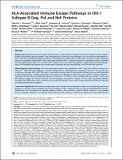HLA-associated immune escape pathways in HIV-1 subtype B Gag, Pol and Nef proteins
Author(s)
Brumme, Zabrina L.; John, Mina; Carlson, Jonathan M.; Brumme, Chanson J.; Chan, Dennison; Brockman, Mark A.; Swenson, Luke C.; Tao, Iris; Szeto, Sharon; Rosato, Pamela; Sela, Jennifer; Kadie, Carl M.; Frahm, Nicole; Brander, Christian; Haas, David W.; Riddler, Sharon A.; Haubrich, Richard; Walker, Bruce D.; Harrigan, P. Richard; Heckerman, David; Mallal, Simon; ... Show more Show less
DownloadBrumme-2009-HLA-associated immun.pdf (1.303Mb)
PUBLISHER_CC
Publisher with Creative Commons License
Creative Commons Attribution
Terms of use
Metadata
Show full item recordAbstract
Background: Despite the extensive genetic diversity of HIV-1, viral evolution in response to immune selective pressures follows broadly predictable mutational patterns. Sites and pathways of Human Leukocyte-Antigen (HLA)-associated polymorphisms in HIV-1 have been identified through the analysis of population-level data, but the full extent of immune escape pathways remains incompletely characterized. Here, in the largest analysis of HIV-1 subtype B sequences undertaken to date, we identify HLA-associated polymorphisms in the three HIV-1 proteins most commonly considered in cellular-based vaccine strategies. Results are organized into protein-wide escape maps illustrating the sites and pathways of HLA-driven viral evolution.
Methodology/Principal Findings: HLA-associated polymorphisms were identified in HIV-1 Gag, Pol and Nef in a multicenter cohort of >1500 chronically subtype-B infected, treatment-naïve individuals from established cohorts in Canada, the USA and Western Australia. At q≤0.05, 282 codons commonly mutating under HLA-associated immune pressures were identified in these three proteins. The greatest density of associations was observed in Nef (where close to 40% of codons exhibited a significant HLA association), followed by Gag then Pol (where ~15–20% of codons exhibited HLA associations), confirming the extensive impact of immune selection on HIV evolution and diversity. Analysis of HIV codon covariation patterns identified over 2000 codon-codon interactions at q≤0.05, illustrating the dense and complex networks of linked escape and secondary/compensatory mutations.
Conclusions/Significance: The immune escape maps and associated data are intended to serve as a user-friendly guide to the locations of common escape mutations and covarying codons in HIV-1 subtype B, and as a resource facilitating the systematic identification and classification of immune escape mutations. These resources should facilitate research in HIV epitope discovery and host-pathogen co-evolution, and are relevant to the continued search for an effective CTL-based AIDS vaccine.
Date issued
2009-08Department
Ragon Institute of MGH, MIT and HarvardJournal
PLoS ONE
Publisher
Public Library of Science
Citation
Brumme, Zabrina L. et al. “HLA-Associated Immune Escape Pathways in HIV-1 Subtype B Gag, Pol and Nef Proteins.” PLoS ONE 4.8 (2009): e6687.
Version: Final published version
ISSN
1932-6203
Keywords
Bill and Melinda Gates Foundation